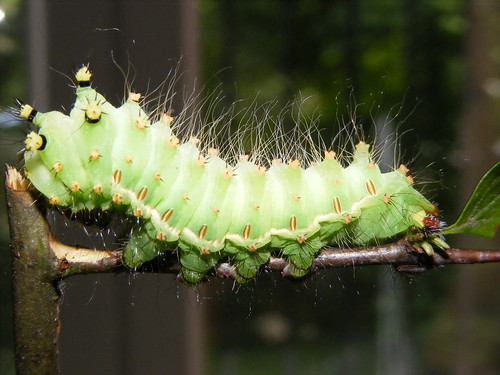Indian Moon Moths (Actius selene) are one of the easiest of the exotic lepidoptera to start keeping. If you want to rear a caterpillar from the egg stage through to a beautiful adult (and even try your hand at breeding them yourself) then you will not be disappointed with these moths.
The adult moths are huge insects, typically a pale, elegant green in colour, with long projections at the rear edge of the wings making them not only tremendously attractive but also very easy to identify.
The caterpillars can often be sourced from breeders in your home country and a quick search online or a visit to an entomological show may turn up a supplier. being so common and easy to breed these are also generally quite a cheap species to get started with too.
Caterpillars will feed on a range of plant species, though I have had greatest success with Hawthorn which can be found from early spring right through to autumn and is an easy plant to identify in the wild. Just be careful of the numerous spines and prickles when you are gathering it for your caterpillars.
Indian moon moth caterpillars typically start off life orange in colour but after a few moults turn into a beautiful green colour with various projections off them.

In my experience, moon moth caterpillars have very healthy appetites and require of plant-matter to feed on if they are to thrive. They also require a reasonably high humidity as they will not often drink and can quickly become dehydrated.
This means that small caterpillars are best housed in small plastic containers such as those one buys livefood in. Line the base of the container with kitchen towel to absorb any excess moisture and then fill the tub with hawthorn. Lastly introduce your new caterpillars.
Try on a daily basis to check on your caterpillars, and breathe gently into the container to add fine water vapour this increasing the humidity in the cage. Also check that the food plant is always fresh and juicy. Old, dry, dead branches should be removed and replaced with new leaves to keep your caterpillars healthy. The higher the humidity in your caterpillar cage, the longer the foodplant will remain alive for.
Maintaining a clean, hygienic environment is essential and so your caterpillars should be regularly cleaned out with the kitchen towel replaced, the tub washed thoroughly in clean water, dried and your caterpillars replaced. Because of this it can be handy to have two or more tubs ready so you can simply transfer your caterpillars over from one tub into a new one and then clean the original one at your leisure.
As the caterpillars grow, so will their appetites and they can be moved up into larger housing. At this point it should be possible to upgrade them into a cage large enough to be able to place the hawthorn ends into a small container of water which keeps the foodplant alive much longer and makes your life much easier.
If you opt to do this, then try to ensure that there is no open water that your caterpillars could drown in if they fall off their leaf. This is easily accomplished by either using a small enough water pot that there is no room between the hawthorn for a caterpillar to go, or to plug any gaps with kitchen towel or cotton wool.
The greatest element for success is really keeping the foodplant alive and juicy and so placing the ends into a container of water really makes life much easier and in this way only a once-a-week clean may be sufficient for them.
In time using this simple setup and regular cleaning you should find your caterpillars finally pupate into their pupae, ready to hatch out as non-feeding adult moths.
- Lava Tarantula / Theraphosinae sp. Panama / Davus sp. Panama Care Sheet - February 4, 2023
- Psalmopoeus victori / Darth Maul Tarantula Care Sheet - February 4, 2023
- Can Praying Mantis Eat Wax Worms? - February 4, 2023

Many thanks for this valuable information! 20 years ago I lived in the mountains here in Shizuoka Prefecture, Japan and was delighted by the Moon Moths that visited. I have not seen any since and would love to try to breed some. I am studying up and reading all I can about it.
I am having no luck finding any breeders here in Japan but have found some in the UK who can send larvae and pupa abroad. However, I worry about the long flight from UK to Japan and then picking them up from the nearest airport … do you have any idea if they can survive such a trip? Or any alternative suggestions apart from the obvious of hunting for the caterpillars in the mountains myself? Thanks!